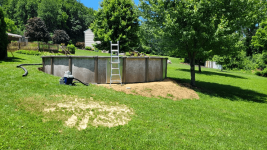You all know I need to chime in here in order to dispel some soils myths:
1) I am (or to be more accurate) was a soils engineer. BS and MS in Civil Engineering, concentration in soils, and ground modification. Worked as a geotechnical engineer when I first got of out college. Don't do that now, but that is how life goes. It's like the guy in Margin Call who was a NASA propulsion engineer but is now a financial risk assessor "it's all just adding up numbers. Just what you are adding up is different"
2) Without performing an analysis of the soil(s) in question the best anybody is doing is guessing. Soil is a natural material. The word "clay" especially in the parlance used here, can mean dozens of things, all with wildly different characteristics. You would not go to an auto parts store and ask for brake pads for "car" or even for a "Ford" you need a specific make, model, and year. Saying you have "clay" is like buying brakes for a "car"
3) The greatest single factor when it comes to compaction of soils is moisture content. If you don't have you soil at the right moisture content you can compact it with whatever you choose, for as long as you want, and guess what, once it dries out or gets wet and gets to that optimum moisture content, it will settle some more. Optimum moisture content is not "I sprayed it real good with a hose". You need to run tests on your soil to determine the optimum moisture content.
4) As I said in #3, moisture content matters, you cannot drive a heavy truck on it, track it in real good, or rent the largest vibratory plate that Home Depot has. There are different types of compactors for different types of soil, for silty clays, or clayey silts, or clays, or silts or organic clays or whatever it is you have, a vibratory plate can do more harm than good.
5) A pool is a horrible thing to build a foundation for. It is a giant, very heavy, unstable bag of water. Aside from the balanced static loading of the wall, there is no structural support for that bag of water that is your pool. Once it gets out of level, it is going to continue to push in that direction as it gets more out of level. An ABG is an unstable system, if you push it to the side, it does not move back to center - it keeps going to the side.
6) Designing a retaining wall to hold back serious loads also requires a solid design. Not just a "lets stack this up and add some tiebacks, that will be good" attitude.
A word on stone dust and QP (and other quarry products). They are usually graded to certain standards, and so you can make assumptions about their compaction curves. QP is especially forgiving with very flat proctor curves, so it is easy to get it to a good compaction percent. But again, for things like a pool foundation, you need to get somebody who knows what they are doing.
Also, when it comes to how water flows through soils and what sort of uplift or heave it causes, that is a whole soil mechanics course on just that subject. Not that it is likely to happen in your pool foundation, but if you get enough rain moving through the soil, it is not just washing away of soils, but also soil liquefaction that can occur.


